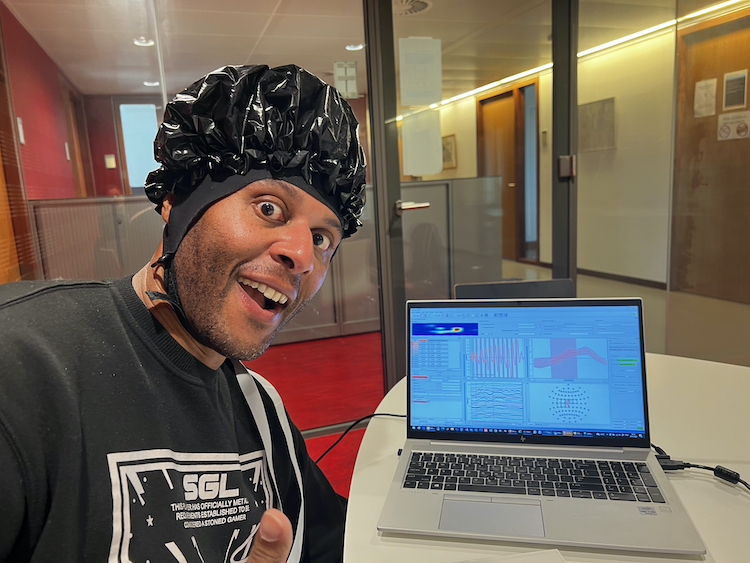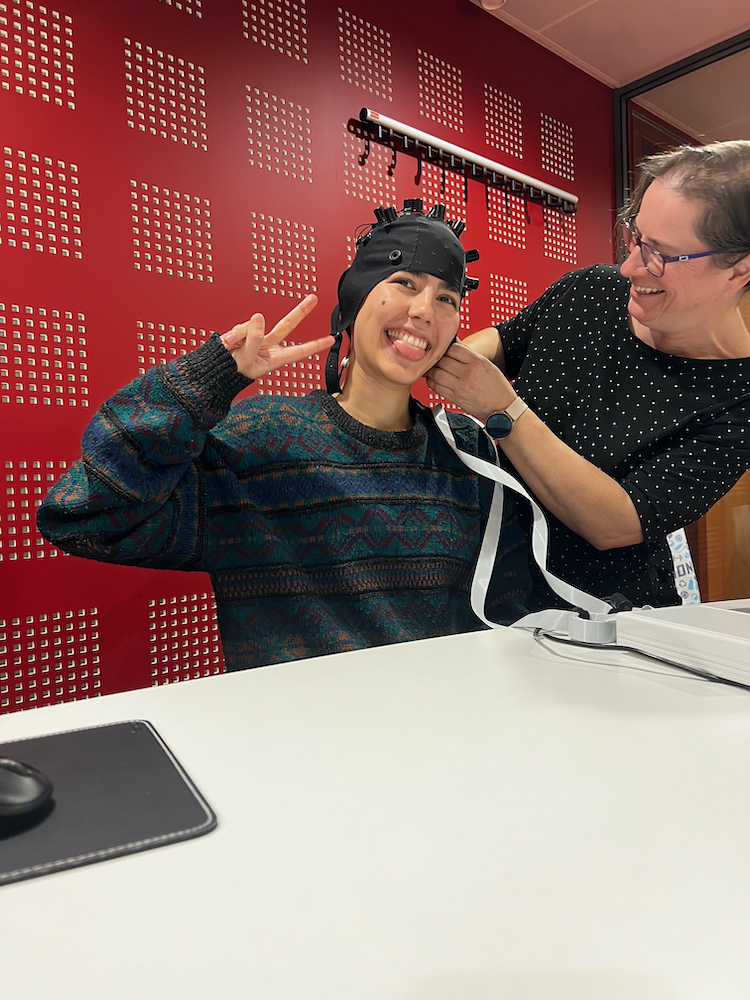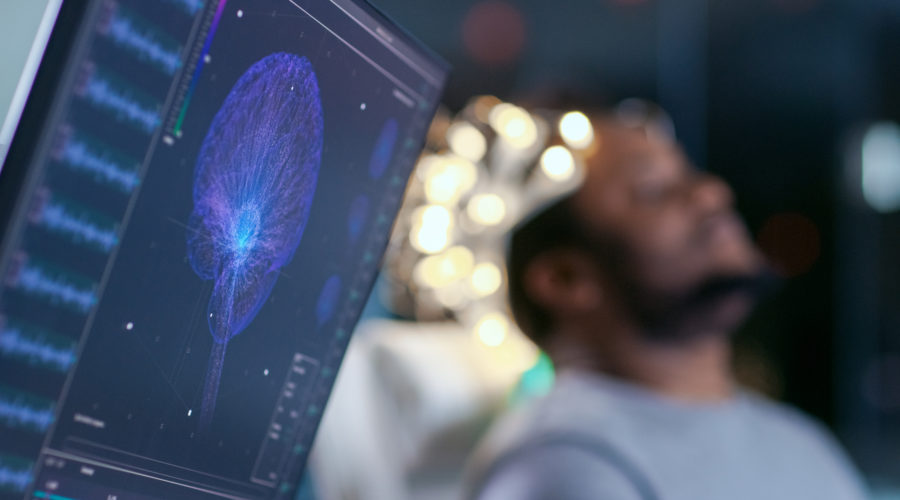fNIRS: What Is It, And What Does It Have To Do With Psychedelics?
Despite what every Mortal Kombat video game has taught you since you were a kid, there are other ways to peer into the human brain without actually taking a buzzsaw and hacking at it until it suddenly pops open like a jar of bread and butter pickles.
That’s a pretty disturbing image, but let’s not forget that neuroscience emerged from brutal things like soaking brains in alcohol and phrenology.
Interested in joining a Psychedelics Clinical Trial? Sign up here now and we will connect you with a clinical trial in your area when one becomes available.
Yes, the field has taken its fair share of stumbles during its inception. But, here we are, finally getting to the point in which we can extract data of brain activity in rather non-invasive ways — at least in a method that doesn’t involve some spectacular decapitation. The practice is neuroimaging, and it’s time to get familiar with functional near-infrared spectroscopy (fNIRS) technology. That’s because it will most likely change the way we view psychedelics in the future.
But why look into the brain at all using fNIRS? What’s so important about it, and what does it have to do with psychedelics?

The Brain And Psychedelics
The brain has different types of neuroreceptors, which are like little keyholes that unlock parts of the brain with these neuroreceptors. The type of neuroreceptor that most psychedelics use are serotonin receptors, also called 5-HT. They are everywhere in your brain, and when you take psychedelics, certain areas of the brain (like the thalamus and amygdala) become active.
When this happens, the “psychedelic trip” occurs — due to this unique brain activity from psychedelics attaching to serotonin neuroreceptors.
During this psychedelic-induced action of the brain, blood and electrical signals in those specific parts of the brain become highly engaged — and, fortunately for science, humans have somehow constructed technology to detect those shifts in blood and electricity. That technology is called neuroimaging, and when it comes to psychedelic brain research, it has the potential to give us insights into the brain that we’ve never had before.
RELATED: Want To Join a Psychedelic Clinical Trial or Study? Here’s What You Need to Know
Electricity In The Brain On Psychedelics
For decades, we’ve been stuck on a very specific type of neuroimaging called EEG, which stands for electroencephalogram. It’s old. In fact, we’re approaching its 100-year anniversary.
EEG is capable of detecting electrical signals in the brain through metallic ‘optodes’. These are small sensors that are placed snugly at various areas on a person’s head. While it’s easy to knock EEG technology for being a dinosaur in the psychedelic neuroscience field, it has yielded some pretty interesting data that is fundamental in how psychedelics innervate the brain.
Actually, one of the first psychedelic studies ever conducted was in 1958 when researchers used EEG on cats that had their skulls removed and electrodes placed directly on their brain. Things may have been brutal then, but, more recently in 2013 at the University of Zurich, researchers found that both ketamine and psilocybin mushrooms impaired the coding of fearful faces.
This means psychedelics actually reduce a person’s emotional response to faces that are frightening. In other words, it’s a discovery that could completely sink the entire Halloween haunted house industry.
Kidding aside, EEG has its place in psychedelic science history (and perhaps the present).
It has some of the best temporal precision in neuroimaging, meaning it can detect exactly when something in the brain takes place; and for how long. As far as exactly where this activity takes place, EEG is a little bit rough on the location. Finding the exact location in the brain where activity is taking place is called ‘spatial precision’. Unfortunately, EEG’s spatial precision isn’t the best.
However, the neuroimaging that has enjoyed much praise in the psychedelic field has undoubtedly been fMRI.
The Blood In Your Brain And Psychedelics
When it comes to spatial precision, which is the ability to see exactly in the brain where activity is happening, fMRI (functional magnetic resonance imaging) shines above the rest. Since its invention in 1991, fMRI has given humanity an opportunity to look inside the brain with stunningly gorgeous images.

So, big news. Your blood is magnetic.
The hemoglobin protein in your blood contains iron, and that iron allows fMRI to detect the ‘magnetic resonance’ of the blood in the brain. Through this magnetic detection, fMRI can precisely locate where this blood is, along with the iron concentration in your blood.
In neuroscience, blood activity in the brain is usually a strong indicator that activity is going down.
When it comes to psychedelics, no one has implemented fMRI technology with greater success than UCSF’s Robin Carhart-Harris. In fact, most of what we know about psychedelics comes directly from fMRI neuroimaging data from Carhart-Harris.
This technology will continue to pave new pathways in psychedelic science, and I’m excited where it all goes — however, this article isn’t about fMRI.
Let’s dive into fNIRS and its potential use for psychedelic science — because that’s why you’re all here.
Let There Be Light… And Psychedelics
While EEG uses electrical signals, and fMRI uses magnetic resonance of blood, fNIRS uses photons of light to detect activity in the brain. It sounds remarkable — because it truly is.
Through optodes affixed to the scalp like EEG, fNIRS uses photons of ‘near-infrared’ light and beams it to your skull. However, it’s only deep enough to penetrate the top layer of the brain. Just like little Star Trek phaser guns that can only shoot an incredibly short range. And hemoglobin in your blood is like a sponge for soaking up this near-infrared light.
Through this light absorption we can see the following:
- The location of blood in the brain
- Concentrations of blood
- Whether this blood is oxygenated (filled with oxygen) or deoxygenated (not filled with oxygen)
Being able to visualize where oxygenated and deoxygenated blood in the brain while on psychedelics can tell us a lot about how these substances impact the brain. The great thing about fNIRS is that it has the temporal precision of EEG combined with the spatial precision fMRI. The best of both worlds. And the brain imaging looks pretty extraordinary as well.
So what has fNIRS revealed about the psychedelic experience? Well, not much. And most of that is due to it being one of the newest neuroimaging technologies.
While fNIRS has been around since the ’90s, the modern technology used for psychedelic science was only created in 2001. The technology is so new that, as of right now, you can count every fNIRS psychedelic study ever conducted using just one hand — actually, it’s just one finger.
Psychedelic fNIRS Is The Loneliest Number
Yep, there’s only one psychedelic fNIRS study that has been conducted. It was published just before the pandemic in February 2020. As a pilot study — meaning it was the first study on fNIRS and psychedelics — its purpose is meant to test parameters and develop ideas for larger studies using the same technology.
The lone psychedelic fNIRS study was conducted by Felix Scholkmann, Lisa Holper, Katrin Preller, and Franz X Vollenweider at the University of Zurich. These researchers wanted to get a general understanding of how deoxygenated and oxygenated blood shifts in the brain while under psilocybin — the psychedelic ingredient of ‘magic mushrooms.’
In this groundbreaking study, 17 milligrams of psilocybin (which is about 1.5 – 2 grams of dried magic mushrooms) were given to a 31-year-old man. ‘Resting-state’ measurements were then taken 30 minutes and 60 minutes after he ingested the psilocybin.
Resting-state measurements is exactly what it sounds like. It’s looking at the brain while a person is inactive, sometimes with their eyes closed, in order to get accurate neural measurements of the effect of a psychedelic.
It’s easy for someone’s attention span to get distracted and focus on something(s) that it shouldn’t. Even just physically moving can exert brain activity and add unnecessary data to fNIRS readings. Resting state forces a person to remain motionless and quiet. It’s almost like a state of meditation, in order to get clean measurements of what psychedelics do to the brain.

Looking At The Brain With fNIRS
The areas of the brain that this fNIRS study looked at were the occipital cortex and the frontal cortex. Both of these areas become very intriguing when a person takes psychedelics.
The occipital cortex, located in the back of your head, is where all your vision eventually gets relayed to. It’s not necessarily where all vision gets processed in the brain, but it’s where the end result of all visual processing goes.
As mentioned earlier, fNIRS can only detect activity at the surface level of the brain.
Fortunately, the visual cortex (V1) is located on the top of the occipital cortex. Without the visual cortex, we couldn’t see anything.
Think of the visual cortex like a giant screen in a movie theate, and your eyes and other parts of your brain operate as the movie projector. In other words, it processes the movie and beams it directly to the screen.
The fNIRS study also looked at the frontal cortex. This is an area of the brain that has been a hot topic in psychedelic science for the past few years.
The frontal cortex helps develop and retain memories, problem solving, behavior, perspectives towards life and language. Surprisingly, all of those things may be altered by psychedelics. Not just while tripping under psychedelics, but these alterations may persist for days, weeks, even months after an initial dose.
It’s not uncommon for people to alleviate things like depression, anxiety, and PTSD after taking psychedelics. If it happens, it most likely occurs within the frontal cortex. This is where the idea of the “Tuesday Blues” comes from.
The Future Of Psychedelics With fNIRS
So what did this study find? Well, it was a pilot study. This means it was seeking to confirm that fNIRS can actually detect shifts in cerebral blood while on psilocybin. The study showed that, in fact, fNIRS can detect these changes — which is revolutionary in psychedelic neuroscience.
Researchers concluded that “we expect that fNIRS will play an important role in future human studies investigating the effects of psychedelics.”
And that is why I’m spending the next four years of my life in The Netherlands.
The pursuit to use fNIRS technology to unravel the psychedelic experience has brought me all the way to Maastricht University. I’m currently studying under world-renowned researchers Bettina Sorger, Kim Kuypers and Jan Raemaekers — each supervisors for my PhD. It’s something that I type out and still can’t believe is actually true. Yet, here I am, butchering the Dutch language on a daily basis.
If fNIRS does “play an important role in future human studies investigating the effects of psychedelics,” I hope to be behind it. Or in front of it. Basically, any direction around or near it is all good. Or, as they say in The Netherlands ‘alles het goed.’




Connie James
September 28, 2022 at 6:43 pmGreat article very informative also enjoy watching your videos on YouTube.
you have a way in communicating medical research.
Jessica Khurana
September 29, 2022 at 5:42 pmGreat article, Zeus!
Anonymous
September 29, 2022 at 10:51 pmGreat article, very straight to the point and a fun read.